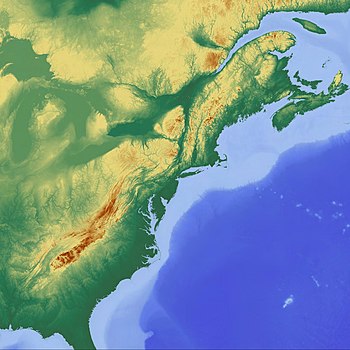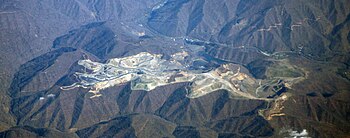Appalachian Mountains

The Appalachian Mountains are a North American mountain chain of 2,000+ miles going from central Alabama to Newfoundland, parallel to the Atlantic Ocean, short, rugged, bunched up, a barrier to early European settlers, subject to strip mining and mountaintop removal, and home to the iconic "A. T." hiking trail.
Medium sized, but rugged and bunched up
The Appalachian mountain chain formed approximately 500 million years ago through the collision of continental plates[1]. Older than the Rocky Mountains or the Himalayas, the Appalachians are nowhere near as high and may not seem imposing, but their rugged, steep, bunched-up formations are typically at around 5000' or higher[2], and they formed a barrier to European settlers hoping to move west in the early days of the United States.
Only one way through for early European settlers
For European settlers trying to go west starting anywhere from North Carolina to New Jersey, there were two southwest-to-northeast mountain ridges that had to be crossed: the Cumberland Mountain ridge (more westerly) and the Pine Mountain ridge (more easterly). There were two gaps across Cumberland Mountain, at either Pennington Gap (Virginia) or, about 40 miles southward, Cumberland Gap. However, there is no easy way across the easterly Pine mountain ridge in the vicinity of Pennington Gap. Thus, Cumberland Gap became the only feasible way through for wagon trains, and in 1775, Daniel Boone led an expedition to blaze a trail across the Cumberland Gap.[3] Cumberland Gap became a famous place and is today the meeting point of three states: Tennessee, Virginia, and Kentucky.
Forty years later (and much farther north), a second, more practical route across the Appalachians was developed when the Erie Canal was built through the Mohawk Valley, across New York state to Buffalo, New York, at the eastern tip of Lake Erie.
Appalachian Trail
In the United Stated, a well-maintained, continuous hiking trail exists along the rim of the Appalachian mountains from Springer Mountain, Georgia to Mount Katahdin, Maine. This iconic, 2200-mile trail is used annually by around 3 million people, and about 3000 people attempt to hike it completely in one season beginning from Georgia in early spring. Only about a quarter of those attempting the through-hike are able to complete the entire trail continuously in one season. It is generally considered a challenging route, requiring five to seven months to complete.
Strip mining and mountaintop removal
In modern times, much of the Appalachian chain in the United States (especially in Kentucky, Virginia, and Pennsylvania) has been subject to surface mining and mountaintop removal, usually for coal. In many cases, all it took was a back hoe and a dump truck. Strip mines and mountaintop removals leave unsightly, erosion-prone areas with no top soil, unable to grow plants, and typically not remediated unless forced to by the government. This surface mining and mountaintop coal removal has been done because it's cheap and easy, and the quick profits from it can then be used to fund deeper, more costly shaft and drift mines. And among some local people, the need for jobs overrode a desire to preserve the land.
Since the 1970's, environmental regulations applied to such practices, but in reality, there was lax enforcement because at first, enforcement was left to the states, which were unable to stop the practice because of local pressures on inspectors. Only after the federal Environmental Protection Agency intervened in regulating the practice in the late 1970's was it slowed (though not stopped). The EPA was able to send inspectors who were not local and thus out of reach of local pressures and influence, and the EPA also had more resources (and resolve) to prosecute violators later in court, whereas the states were generally not very effective at preventing the violations or seeking remediation of stripped land.
References
- ↑ Geology of the Appalachian Mountains from Encyclopedia Brittanica online.
- ↑ The highest peak in the Appalachians is Mount Mitchell in North Carolina at 6,684 feet above sea level.
- ↑ See The Cumberland Gap on danielboonetrail.com for more details.

